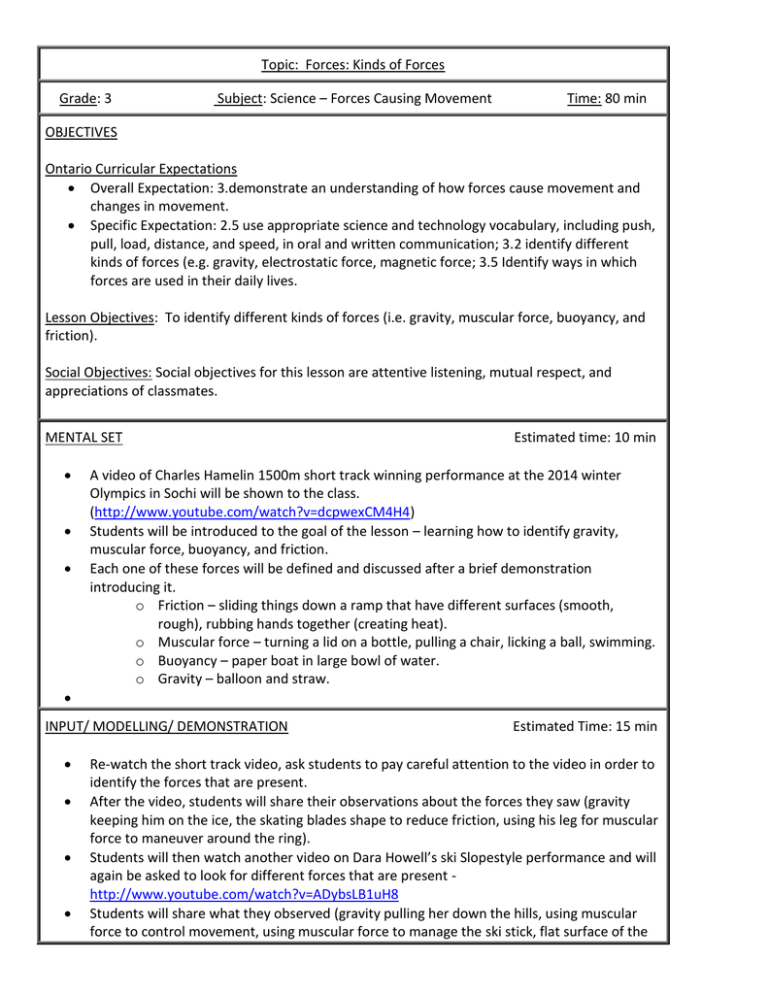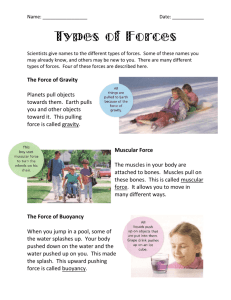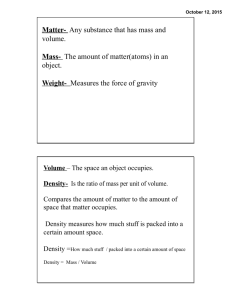Science Lesson - Kinds of Forces
advertisement

Topic: Forces: Kinds of Forces Grade: 3 Subject: Science – Forces Causing Movement Time: 80 min OBJECTIVES Ontario Curricular Expectations Overall Expectation: 3.demonstrate an understanding of how forces cause movement and changes in movement. Specific Expectation: 2.5 use appropriate science and technology vocabulary, including push, pull, load, distance, and speed, in oral and written communication; 3.2 identify different kinds of forces (e.g. gravity, electrostatic force, magnetic force; 3.5 Identify ways in which forces are used in their daily lives. Lesson Objectives: To identify different kinds of forces (i.e. gravity, muscular force, buoyancy, and friction). Social Objectives: Social objectives for this lesson are attentive listening, mutual respect, and appreciations of classmates. MENTAL SET Estimated time: 10 min A video of Charles Hamelin 1500m short track winning performance at the 2014 winter Olympics in Sochi will be shown to the class. (http://www.youtube.com/watch?v=dcpwexCM4H4) Students will be introduced to the goal of the lesson – learning how to identify gravity, muscular force, buoyancy, and friction. Each one of these forces will be defined and discussed after a brief demonstration introducing it. o Friction – sliding things down a ramp that have different surfaces (smooth, rough), rubbing hands together (creating heat). o Muscular force – turning a lid on a bottle, pulling a chair, licking a ball, swimming. o Buoyancy – paper boat in large bowl of water. o Gravity – balloon and straw. INPUT/ MODELLING/ DEMONSTRATION Estimated Time: 15 min Re-watch the short track video, ask students to pay careful attention to the video in order to identify the forces that are present. After the video, students will share their observations about the forces they saw (gravity keeping him on the ice, the skating blades shape to reduce friction, using his leg for muscular force to maneuver around the ring). Students will then watch another video on Dara Howell’s ski Slopestyle performance and will again be asked to look for different forces that are present http://www.youtube.com/watch?v=ADybsLB1uH8 Students will share what they observed (gravity pulling her down the hills, using muscular force to control movement, using muscular force to manage the ski stick, flat surface of the skis to reduce friction). PRACTICE Estimated time: 20 min Students will use pictures of athletes performing in Olympic Games that will be given to them to identify different forces that are at work. First students will talk about the picture with their group and identify the forces together. Then they will write down all the forces they see in the chart provided. When students are done filling in their charts, they will answer the 3 questions on the first worksheet and the three questions on the second worksheet. Students who are finished early can look at the images depicting activities during the different seasons and identify the forces in those pictures. Materials: Definitions for word wall Balloon Straw Sand paper Books Water bottle Large bowl Paper boat Olympics pictures Chart paper and markers CHECKS FOR UNDERSTANDING Teacher observations and one-on-one discussion/questioning during practice Assess charts for appropriate identification of the different forces. Whole class dialogue for consolidation CLOSURE Estimated Time: 10 min Whole Class Discussion – each picture will be discussed in terms of the forces that were observed. Students who did not complete their charts will get an opportunity to write some examples down. CONSIDERATIONS Multiple Intelligences: Accommodations: - verbal linguistic * - logical/mathematical - musical/rhythmic - bodily/kinesthetic * - visual/spatial * - interpersonal * - intrapersonal * - naturalist * - existential Who: Student who take longer to finish. How: Give them extra time. Who: ELL student How: use pictures in word wall and pair with a student to translate questions. Assist them with answering questions on worksheet. Assessment: - self-evaluation - group evaluation - teacher evaluation - observation * - anecdotal notes - quiz/test - checklist - rubric - interview - discussion * - work books * GRAVITY: the pulling force of a large object (like Earth). MUSCULAR FORCE: your muscles causing pulling on your bones to cause your body to move. BUOYANCY: the pushing force of a liquid or a gas. FRICTION: the rubbing force between two objects.





